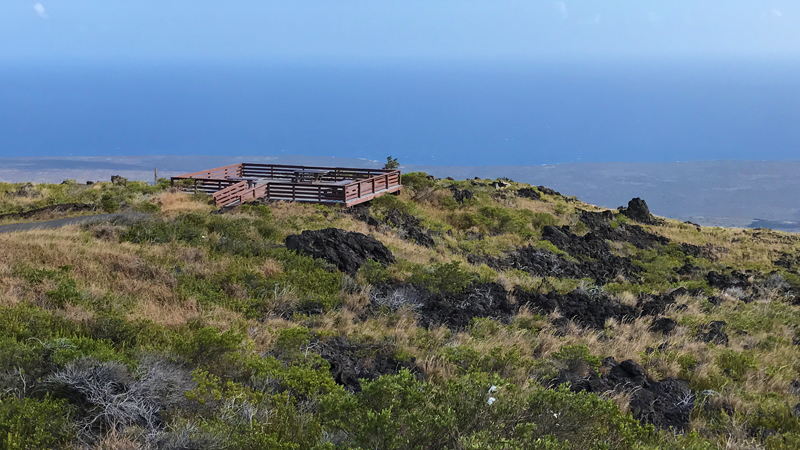
With stark contrasts of barren, rough, lava covered landscapes and lush, green topical forest habitats, Hawai’i Volcanoes National Park is a magnificent destination for a family vacation. From the steam vents and sulfur banks, to craters and active volcanoes bubbling with lava, to lava tubes and petroglyphs, there really is something for everyone.
By the time we reached the Kealakomo Lookout, we all breathed a sign of relief and Carter even said, “Hooray, not another crater!” After visiting the Kīlauea Iki, Lua Manu, Puhimau, Ko’oko’olau, and Pauahi craters, and the Mauna Ulu cone and crater, we were ready for something different!
Perched on the edge of the Hōlei Pali cliff, 2,000 feet above sea level, the Kealakomo Lookout offers visitors spectacular panoramic views of the Pacific Ocean, the Hawaii coastline, vast lava flows, and the former location of a village that was destroyed by lava. On a clear day, you can even see South Point.
Hōlei Pali is part of a system of fault escarpments where the coastal plain has fallen over the years as much as 1,400 feet away from Kīlauea. In 1975 an earthquake created major movement along the faults, dropping the land almost 10 feet and sliding it almost 20 feet toward the ocean. This caused a small tsunami that killed a couple men and some horses who were camping at Halape.
While the views from the Kealakomo Lookout are amazing, we didn’t stay long after snapping some photos because it was insanely windy. Plus, it was getting later in the afternoon and we still wanted to visit the Pu’u Loa Petroglyphs and the Holei Sea Arch before dark!
Kealakomo Village
Kealakomo Village was an ancient Hawaiian coastal village and salt producing center. Dried fish was exported from Kealakomo inland in exchange for taro, tapas, and other items that could not be produced along the dry coastal land.
Most of the village area was covered by lava in 1971 during the Mauna Ulu eruption. From the cliffs to the coastline, dull black a’a lava and silvery-grey pahoehoe lava from Mauna Ulu cover the landscape. Over the five years of this eruption, 200 new acres of land were added to the Big Island of Hawaii.
Know Before You Go
- The Kealakomo Lookout is located 3.5 miles from the Mau Loa O Mauna Ulu Lookout, 9.9 miles from the start of Chain Of Craters Road, and 13.2 miles from the Kīlauea Visitor Center on Chain Of Craters Road in Hawai’i Volcanoes National Park.
- Kealakomo means the entrance path.
- The lookout observation platform offers visitors stunning panoramic views of the Pacific Ocean, the Hawaii coastline, and a vast lava field that covered portions of the ancient village of Kealakomo.





